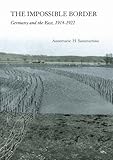The Impossible Border : Germany and the East, 1914–1922 / Annemarie H. Sammartino.
Material type: TextPublisher: Ithaca, NY : Cornell University Press, [2014]Copyright date: ©2014Description: 1 online resource (248 p.) : 2 halftones, 3 mapsContent type:
TextPublisher: Ithaca, NY : Cornell University Press, [2014]Copyright date: ©2014Description: 1 online resource (248 p.) : 2 halftones, 3 mapsContent type: - 9780801471193
- 943.085 22/ger
- online - DeGruyter
| Item type | Current library | Call number | URL | Status | Notes | Barcode | |
|---|---|---|---|---|---|---|---|
 eBook
eBook
|
Biblioteca "Angelicum" Pont. Univ. S.Tommaso d'Aquino Nuvola online | online - DeGruyter (Browse shelf(Opens below)) | Online access | Not for loan (Accesso limitato) | Accesso per gli utenti autorizzati / Access for authorized users | (dgr)9780801471193 |
Frontmatter -- Contents -- Acknowledgments -- Abbreviations -- Introduction: The Crisis of Sovereignty -- 1. “German Brothers”: War and Migration -- 2. “Now We Were the Border”: The Freikorps Baltic Campaign -- 3. Socialist Pioneers on the Soviet Frontier: Ansiedlung Ost -- 4. “We Who Suffered Most”: The Immigration of Germans from Poland -- 5. “A Flooding of the Reich with Foreigners”: The Frustrations of Border Control -- 6. Anti-Bolshevism and the Bolshevik Prisoners of War -- 7. “A Firm Inner Connection to Germany”: Naturalization Policy -- 8. Tolerance and Its Limits: Russians, Jews, and Asylum -- Conclusion: The Legacy of Crisis -- Appendix: Maps -- Bibliography -- Index
restricted access online access with authorization star
http://purl.org/coar/access_right/c_16ec
Between 1914 and 1922, millions of Europeans left their homes as a result of war, postwar settlements, and revolution. After 1918, the immense movement of people across Germany's eastern border posed a sharp challenge to the new Weimar Republic. Ethnic Germans flooded over the border from the new Polish state, Russian émigrés poured into the German capital, and East European Jews sought protection in Germany from the upheaval in their homelands. Nor was the movement in one direction only: German Freikorps sought to found a soldiers' colony in Latvia, and a group of German socialists planned to settle in a Soviet factory town.In The Impossible Border, Annemarie H. Sammartino explores these waves of migration and their consequences for Germany. Migration became a flashpoint for such controversies as the relative importance of ethnic and cultural belonging, the interaction of nationalism and political ideologies, and whether or not Germany could serve as a place of refuge for those seeking asylum. Sammartino shows the significance of migration for understanding the difficulties confronting the Weimar Republic and the growing appeal of political extremism.Sammartino demonstrates that the moderation of the state in confronting migration was not merely by default, but also by design. However, the ability of a republican nation-state to control its borders became a barometer for its overall success or failure. Meanwhile, debates about migration were a forum for political extremists to develop increasingly radical understandings of the relationship between the state, its citizens, and its frontiers. The widespread conviction that the democratic republic could not control its "impossible" Eastern borders fostered the ideologies of those on the radical right who sought to resolve the issue by force and for all time.
Mode of access: Internet via World Wide Web.
In English.
Description based on online resource; title from PDF title page (publisher's Web site, viewed 26. Apr 2024)


